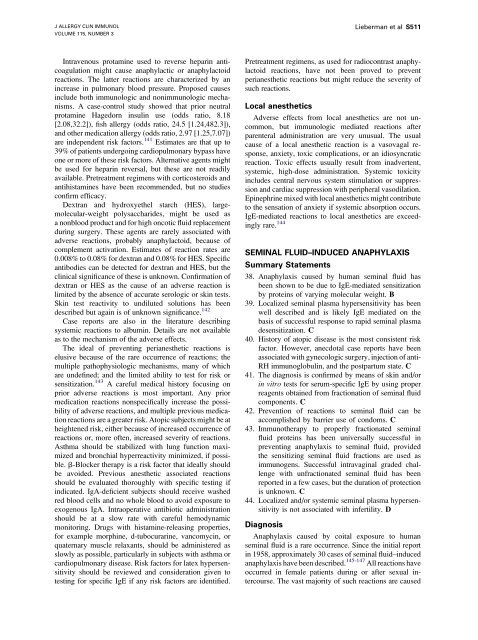Immunotherapy Safety for the Primary Care ... - U.S. Coast Guard
Immunotherapy Safety for the Primary Care ... - U.S. Coast Guard
Immunotherapy Safety for the Primary Care ... - U.S. Coast Guard
Create successful ePaper yourself
Turn your PDF publications into a flip-book with our unique Google optimized e-Paper software.
J ALLERGY CLIN IMMUNOL<br />
VOLUME 115, NUMBER 3<br />
Lieberman et al S511<br />
Intravenous protamine used to reverse heparin anticoagulation<br />
might cause anaphylactic or anaphylactoid<br />
reactions. The latter reactions are characterized by an<br />
increase in pulmonary blood pressure. Proposed causes<br />
include both immunologic and nonimmunologic mechanisms.<br />
A case-control study showed that prior neutral<br />
protamine Hagedorn insulin use (odds ratio, 8.18<br />
[2.08,32.2]), fish allergy (odds ratio, 24.5 [1.24,482.3]),<br />
and o<strong>the</strong>r medication allergy (odds ratio, 2.97 [1.25,7.07])<br />
are independent risk factors. 141 Estimates are that up to<br />
39% of patients undergoing cardiopulmonary bypass have<br />
one or more of <strong>the</strong>se risk factors. Alternative agents might<br />
be used <strong>for</strong> heparin reversal, but <strong>the</strong>se are not readily<br />
available. Pretreatment regimens with corticosteroids and<br />
antihistamines have been recommended, but no studies<br />
confirm efficacy.<br />
Dextran and hydroxye<strong>the</strong>l starch (HES), largemolecular-weight<br />
polysaccharides, might be used as<br />
a nonblood product and <strong>for</strong> high oncotic fluid replacement<br />
during surgery. These agents are rarely associated with<br />
adverse reactions, probably anaphylactoid, because of<br />
complement activation. Estimates of reaction rates are<br />
0.008% to 0.08% <strong>for</strong> dextran and 0.08% <strong>for</strong> HES. Specific<br />
antibodies can be detected <strong>for</strong> dextran and HES, but <strong>the</strong><br />
clinical significance of <strong>the</strong>se is unknown. Confirmation of<br />
dextran or HES as <strong>the</strong> cause of an adverse reaction is<br />
limited by <strong>the</strong> absence of accurate serologic or skin tests.<br />
Skin test reactivity to undiluted solutions has been<br />
described but again is of unknown significance. 142<br />
Case reports are also in <strong>the</strong> literature describing<br />
systemic reactions to albumin. Details are not available<br />
as to <strong>the</strong> mechanism of <strong>the</strong> adverse effects.<br />
The ideal of preventing perianes<strong>the</strong>tic reactions is<br />
elusive because of <strong>the</strong> rare occurrence of reactions; <strong>the</strong><br />
multiple pathophysiologic mechanisms, many of which<br />
are undefined; and <strong>the</strong> limited ability to test <strong>for</strong> risk or<br />
sensitization. 143 A careful medical history focusing on<br />
prior adverse reactions is most important. Any prior<br />
medication reactions nonspecifically increase <strong>the</strong> possibility<br />
of adverse reactions, and multiple previous medication<br />
reactions are a greater risk. Atopic subjects might be at<br />
heightened risk, ei<strong>the</strong>r because of increased occurrence of<br />
reactions or, more often, increased severity of reactions.<br />
Asthma should be stabilized with lung function maximized<br />
and bronchial hyperreactivity minimized, if possible.<br />
b-Blocker <strong>the</strong>rapy is a risk factor that ideally should<br />
be avoided. Previous anes<strong>the</strong>tic associated reactions<br />
should be evaluated thoroughly with specific testing if<br />
indicated. IgA-deficient subjects should receive washed<br />
red blood cells and no whole blood to avoid exposure to<br />
exogenous IgA. Intraoperative antibiotic administration<br />
should be at a slow rate with careful hemodynamic<br />
monitoring. Drugs with histamine-releasing properties,<br />
<strong>for</strong> example morphine, d-tubocurarine, vancomycin, or<br />
quaternary muscle relaxants, should be administered as<br />
slowly as possible, particularly in subjects with asthma or<br />
cardiopulmonary disease. Risk factors <strong>for</strong> latex hypersensitivity<br />
should be reviewed and consideration given to<br />
testing <strong>for</strong> specific IgE if any risk factors are identified.<br />
Pretreatment regimens, as used <strong>for</strong> radiocontrast anaphylactoid<br />
reactions, have not been proved to prevent<br />
perianes<strong>the</strong>tic reactions but might reduce <strong>the</strong> severity of<br />
such reactions.<br />
Local anes<strong>the</strong>tics<br />
Adverse effects from local anes<strong>the</strong>tics are not uncommon,<br />
but immunologic mediated reactions after<br />
parenteral administration are very unusual. The usual<br />
cause of a local anes<strong>the</strong>tic reaction is a vasovagal response,<br />
anxiety, toxic complications, or an idiosyncratic<br />
reaction. Toxic effects usually result from inadvertent,<br />
systemic, high-dose administration. Systemic toxicity<br />
includes central nervous system stimulation or suppression<br />
and cardiac suppression with peripheral vasodilation.<br />
Epinephrine mixed with local anes<strong>the</strong>tics might contribute<br />
to <strong>the</strong> sensation of anxiety if systemic absorption occurs.<br />
IgE-mediated reactions to local anes<strong>the</strong>tics are exceedingly<br />
rare. 144<br />
SEMINAL FLUID–INDUCED ANAPHYLAXIS<br />
Summary Statements<br />
38. Anaphylaxis caused by human seminal fluid has<br />
been shown to be due to IgE-mediated sensitization<br />
by proteins of varying molecular weight. B<br />
39. Localized seminal plasma hypersensitivity has been<br />
well described and is likely IgE mediated on <strong>the</strong><br />
basis of successful response to rapid seminal plasma<br />
desensitization. C<br />
40. History of atopic disease is <strong>the</strong> most consistent risk<br />
factor. However, anecdotal case reports have been<br />
associated with gynecologic surgery, injection of anti-<br />
RH immunoglobulin, and <strong>the</strong> postpartum state. C<br />
41. The diagnosis is confirmed by means of skin and/or<br />
in vitro tests <strong>for</strong> serum-specific IgE by using proper<br />
reagents obtained from fractionation of seminal fluid<br />
components. C<br />
42. Prevention of reactions to seminal fluid can be<br />
accomplished by barrier use of condoms. C<br />
43. <strong>Immuno<strong>the</strong>rapy</strong> to properly fractionated seminal<br />
fluid proteins has been universally successful in<br />
preventing anaphylaxis to seminal fluid, provided<br />
<strong>the</strong> sensitizing seminal fluid fractions are used as<br />
immunogens. Successful intravaginal graded challenge<br />
with unfractionated seminal fluid has been<br />
reported in a few cases, but <strong>the</strong> duration of protection<br />
is unknown. C<br />
44. Localized and/or systemic seminal plasma hypersensitivity<br />
is not associated with infertility. D<br />
Diagnosis<br />
Anaphylaxis caused by coital exposure to human<br />
seminal fluid is a rare occurrence. Since <strong>the</strong> initial report<br />
in 1958, approximately 30 cases of seminal fluid–induced<br />
anaphylaxis have been described. 145-147 All reactions have<br />
occurred in female patients during or after sexual intercourse.<br />
The vast majority of such reactions are caused
















